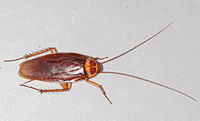American cockroach: Difference between revisions
Waldyrious (talk | contribs) standard date format in {{cite web}} |
|||
| Line 44: | Line 44: | ||
== Control == |
== Control == |
||
impossible. you fail. |
|||
Due to their large size and slow development, large infestations of these insects are not common within houses. However, during certain times of the year, these cockroaches may move inside a house from outside. In cold weather these cockroaches may move indoors, seeking warmer temperatures and food. Cockroaches may enter houses via [[sewer]] connections, under [[door]]s, around [[plumbing]], [[duct|air duct]]s, or other openings in the foundation. Cockroach populations may be controlled through the use of insecticides, removing the food supply, or by physically excluding them from unwanted areas. |
|||
== See also == |
== See also == |
||
Revision as of 01:14, 6 October 2008
| American cockroach | |
|---|---|

| |
| Scientific classification | |
| Kingdom: | |
| Phylum: | |
| Class: | |
| Order: | |
| Family: | |
| Genus: | |
| Species: | P. americana
|
| Binomial name | |
| Periplaneta americana Linnaeus, 1758
| |
The American cockroach (Periplaneta americana) is a large species of winged cockroach. It is very common in the southern United States, and in tropical climates, and can be found in many locations throughout the world, due to its travels via shipping and commerce between locations. In the southern U.S., it is often called a Palmetto Bug or a Waterbug. Sightings have been reported in the northeast U.S., such as in New York City, southcentral Canada, such as in Toronto and southeast Canada, such as in Montreal, where it is mostly found near human habitations due to its lack of cold tolerance.[citation needed] The American cockroach can also be found near various ports throughout the world, such as Cape Town and Durban, South Africa. They are the largest species of common cockroach.
The insect is believed to have originated in Africa, but had become established in the southern U.S. by the time that it was given its name.
The insect is often considered a pest since it invades living quarters for sanctuary and food.
Characteristics
American cockroach adults grow to an average length of around 4 centimetres (1.6 in).[1] They are reddish brown and have a yellowish margin on the body region behind the head. Immature cockroaches resemble adults except that they are wingless.
The insect can travel quickly, often darting out of sight when someone enters a room, and can fit into small cracks and under doors despite its fairly large size. It is considered one of the fastest running insects.[2]
In an experiment carried out at the University of California at Berkeley (USA) in 1991, a Periplaneta americana registered a record speed of 5.4 kilometres per hour (3.4 mph), about 50 body lengths per second, which would be comparable to a human running at 330 km/h (205 mph).[3][4]
Habitat
American cockroaches generally live in moist areas, but can survive in dry areas if they have access to water. They prefer warm temperatures around 29 °C (84 °F) and do not tolerate cold temperatures. In residential areas, these cockroaches live in basements and sewers, and may move outdoors into yards during warm weather. These cockroaches are common in basements, crawl spaces, cracks and crevices of porches, foundations, and walkways adjacent to buildings. They feed on a wide variety of plant and animal material.
Life cycle
Females produce egg cases and carry them protruding from the tip of the abdomen for about two days. Egg cases are then generally placed on a surface in a hidden location. Egg cases are about 0.9 centimetres (0.35 in) long, brown, and purse shaped. Immature cockroaches emerge from egg cases in 6 to 8 weeks and require 6 to 12 months to mature. Adult cockroaches can live up to one year, during which females produce an average of 150 young.
Control
impossible. you fail.
See also
- Blattellidae - a list of other cockroach species
Gallery
References
- ^ Barbara, Kathryn A. (2008). American cockroach - Periplaneta americana (Linnaeus). Retrieved on 2008-07-10 from http://creatures.ifas.ufl.edu/urban/roaches/american_cockroach.htm.
- ^ Thomas M. Merritt (1999-07-31). "Chapter 39 — Fastest Runner". Book of Insect Records. University of Florida.
- ^ Shukolyukov, S. A. (2001-09-27). Discovering The Achievements Of The American Cockroach. University Science News. Retrieved on 2008-07-10 from http://www.unisci.com/stories/20013/0927016.htm.
- ^ "Fastest Land Insect".
External links
- An Ohio State University Entomology article on the American Cockroach
- Gallery of cockroaches
- Order Blattodea, Exploring California Insects
- American Cockroach — Virginia Cooperative Extension
- American cockroach egg parasitoid on the UF / IFAS Featured Creatures Web site





